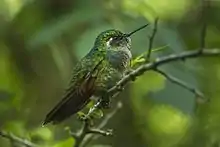Garnet-throated hummingbird
The garnet-throated hummingbird (Lamprolaima rhami) is a species of hummingbird in the family Trochilidae. It is found in El Salvador, Guatemala, Honduras, and Mexico. It is in the monotypical genus Lamprolaima.
| Garnet-throated hummingbird | |
|---|---|
 | |
| Scientific classification | |
| Kingdom: | Animalia |
| Phylum: | Chordata |
| Class: | Aves |
| Order: | Apodiformes |
| Family: | Trochilidae |
| Tribe: | Lampornithini |
| Genus: | Lamprolaima L. Reichenbach, 1854 |
| Species: | L. rhami |
| Binomial name | |
| Lamprolaima rhami (Lesson, 1838) | |
 | |
Its natural habitat is subtropical or tropical moist montane forest.
Systematics
First described by Rene Primevere Lesson as Ornismya rhami in 1838, the garnet-throated hummingbird was moved to its current genus, Lamprolaima, by Ludwig Reichenbach in 1854.[2]
It is the only member of the genus Lamprolaima,[3] a name which is a combination of two Greek words: lampros, meaning brilliant or radiant and laimos, meaning throat.[4] The specific epithet commemorates Henri-Casimir de Rham, a Swiss diplomat to the United States who was founder of the Swiss Benevolent Society in New York, a businessman, naturalist and collector.[5]
Description
The garnet-throated hummingbird is a large hummingbird, ranging from 4.5 to 5 in (11 to 13 cm) in length[6] and from 7 to 9.5 g (0.25 to 0.34 oz) in weight.[7] The male has an iridescent emerald green back, bright rufous wings and a dark purple tail. His chest is iridescent violet, his abdomen black, and his throat has an iridescent garnet-red patch surrounded by black. The female lacks the throat and chest colors of the male; instead, she is sooty gray below.[6]
Conservation and threats
Although the International Union for the Conservation of Nature lists this species as being of Least Concern,[1] the Mexican government lists it as Threatened.[8]
References
- BirdLife International (2012). "Lamprolaima rhami". IUCN Red List of Threatened Species. 2012. Retrieved 26 November 2013.CS1 maint: ref=harv (link)
- Jobling, p. 295.
- Jobling, p. 334.
Cited texts
- Jobling, James A. (2010). Helm Dictionary of Scientific Bird Names. London, UK: Christopher Helm. ISBN 978-1-4081-2501-4.
